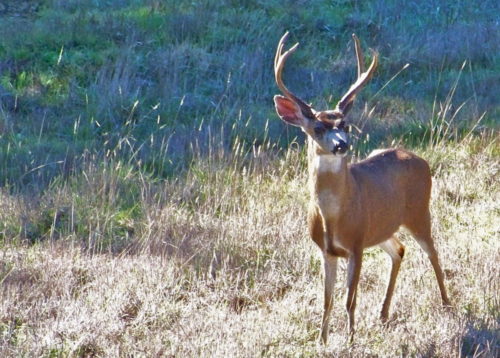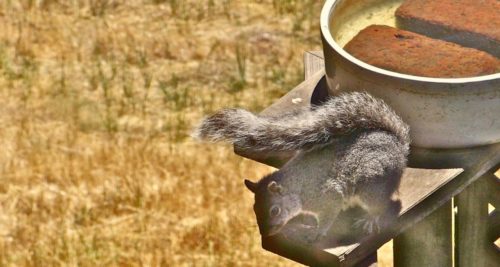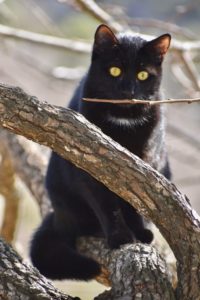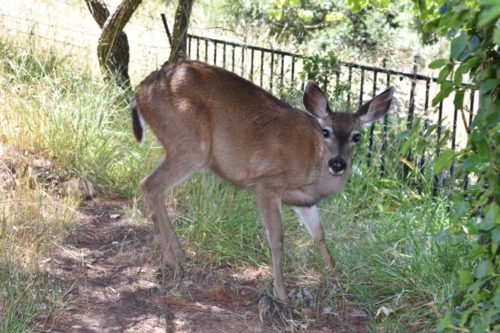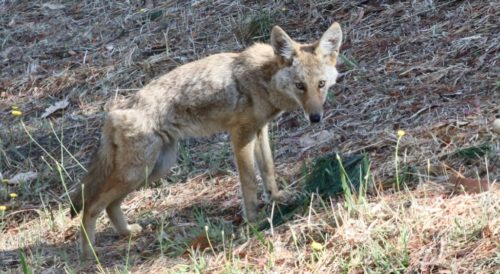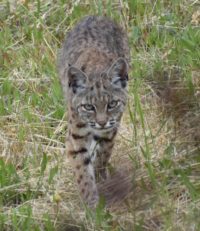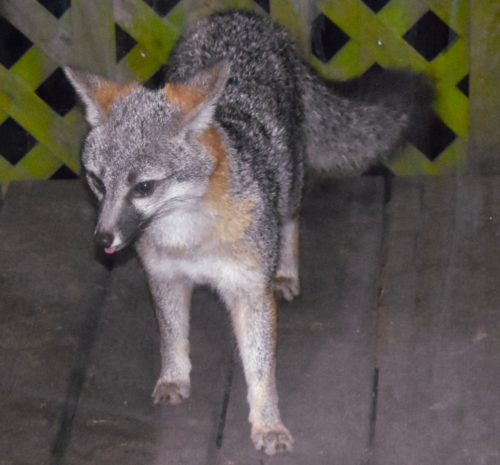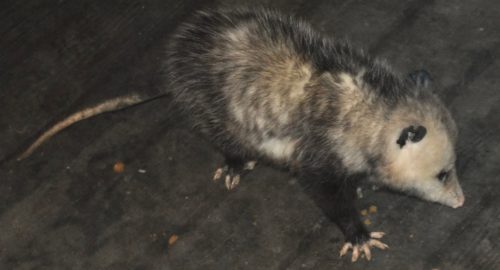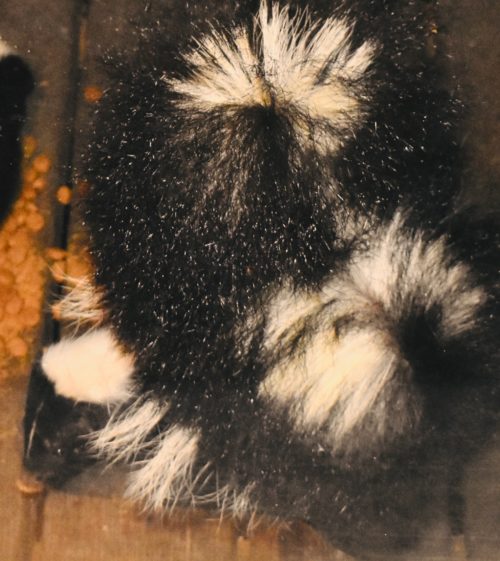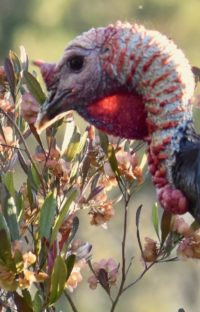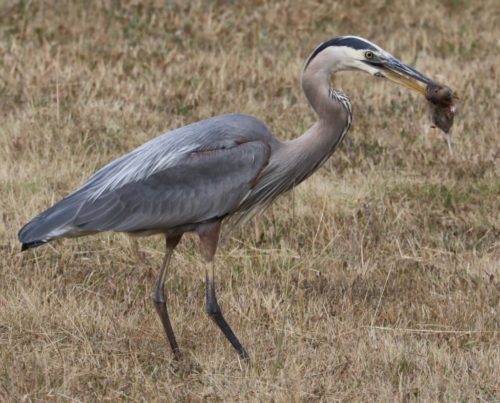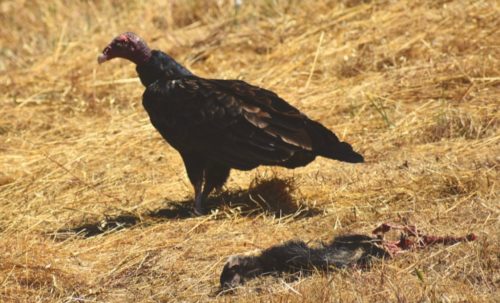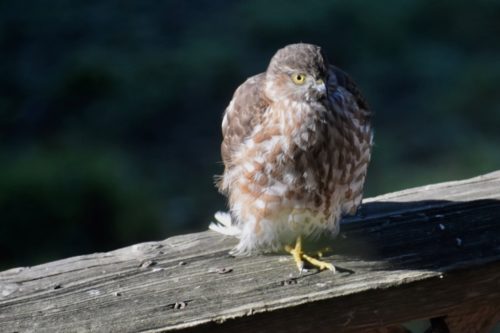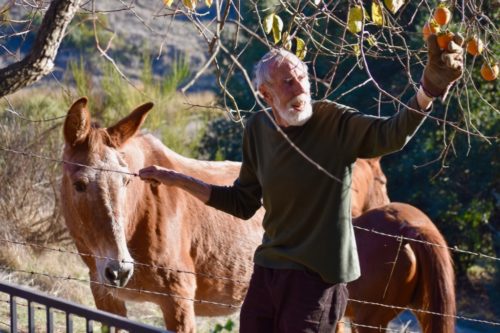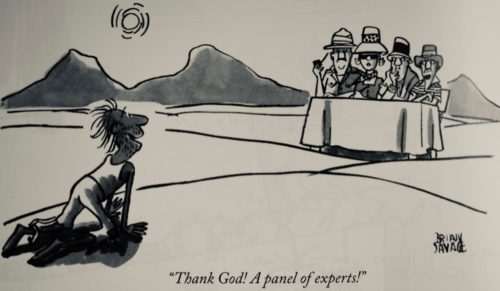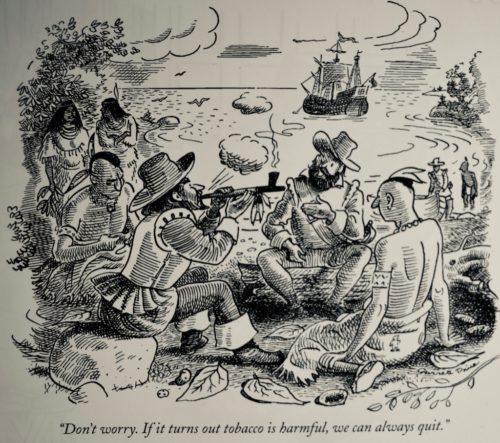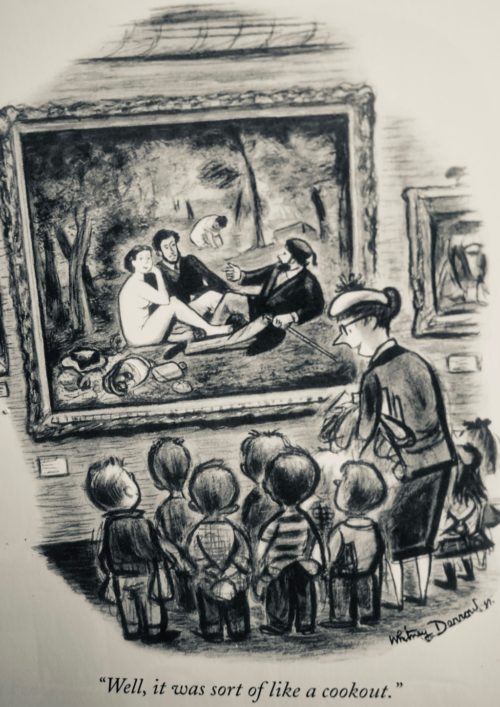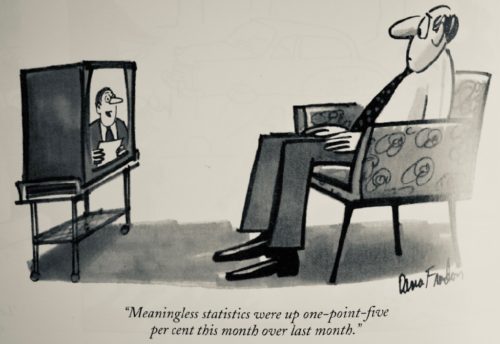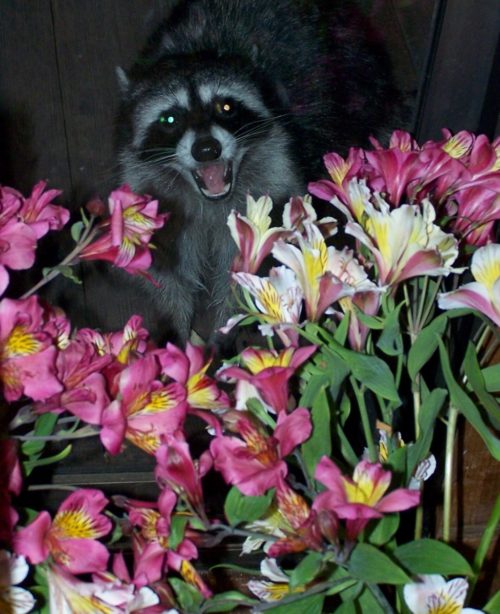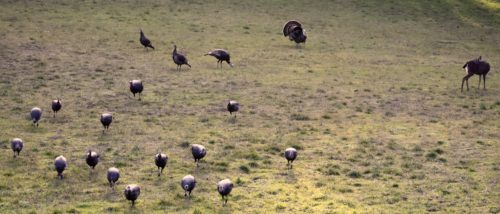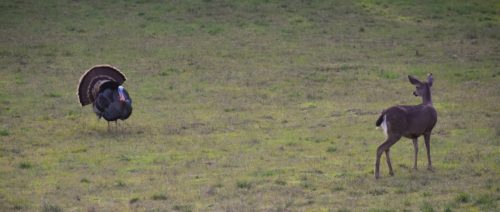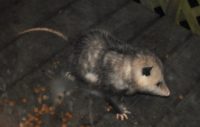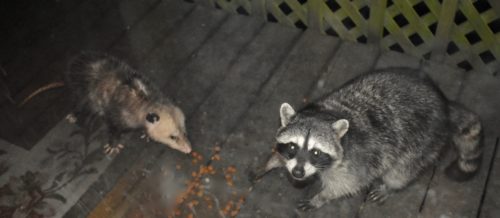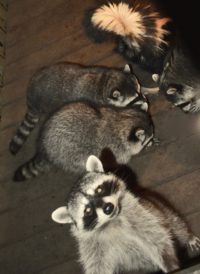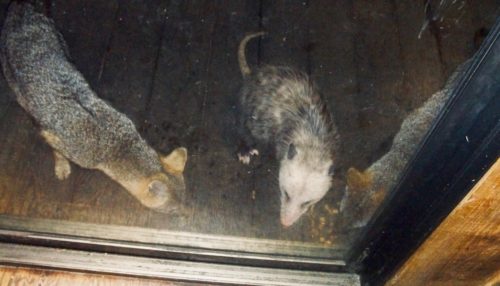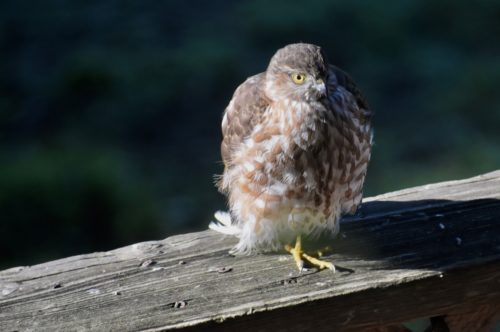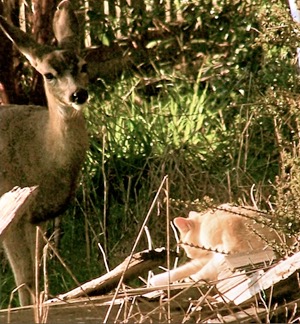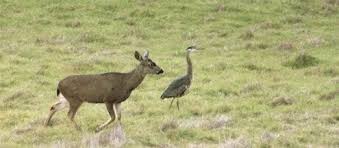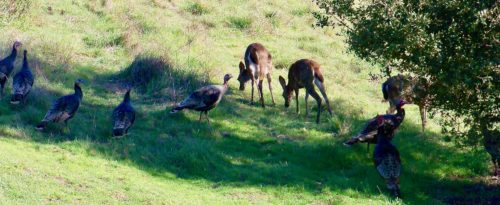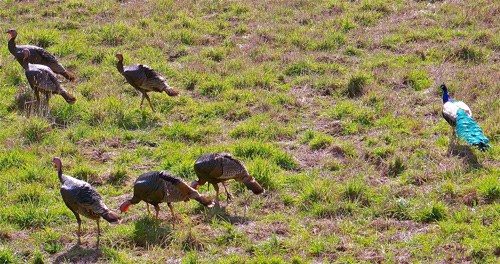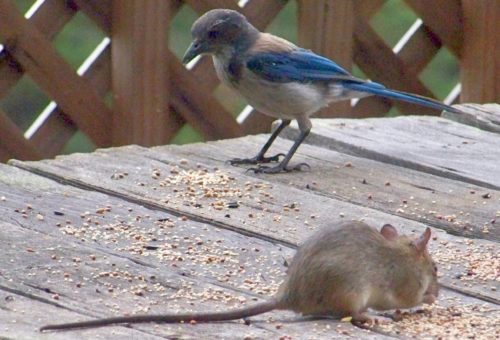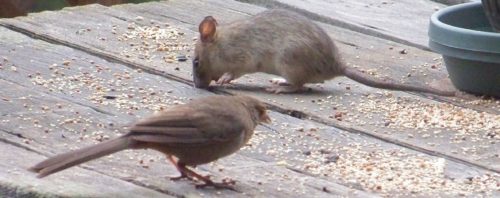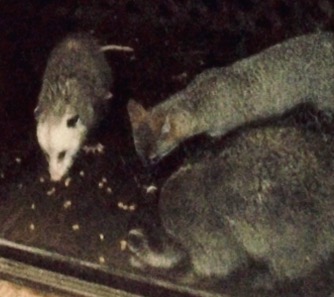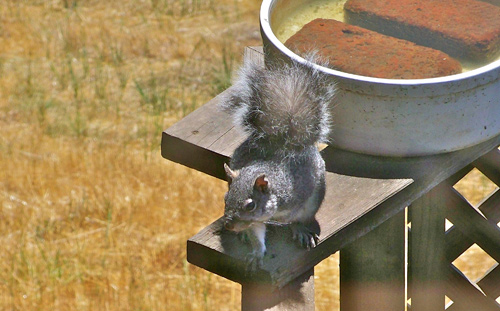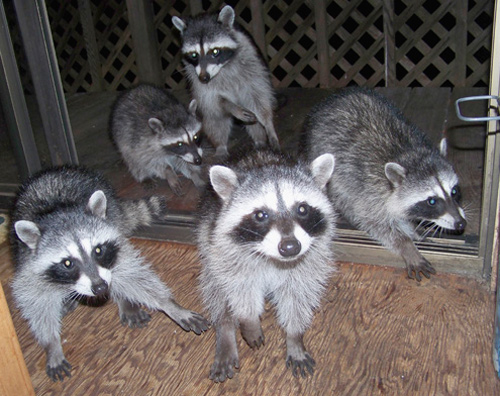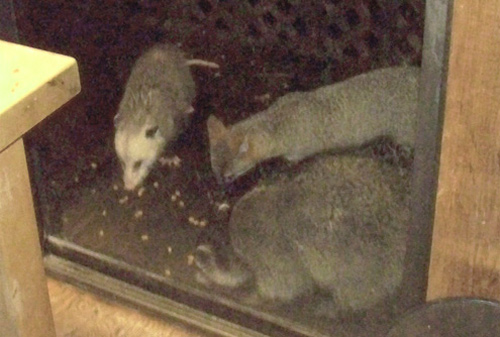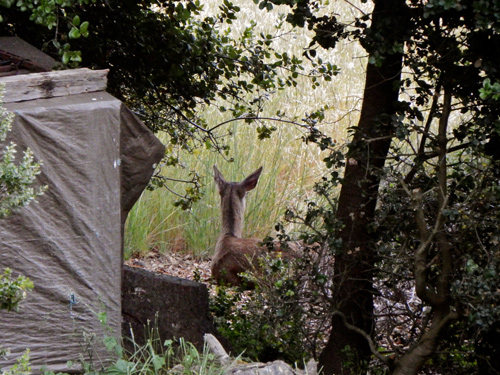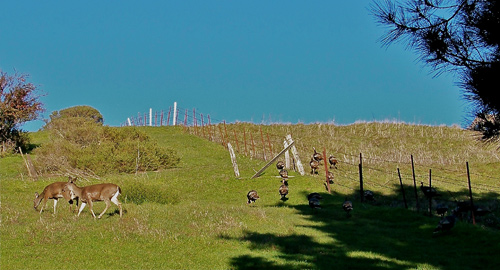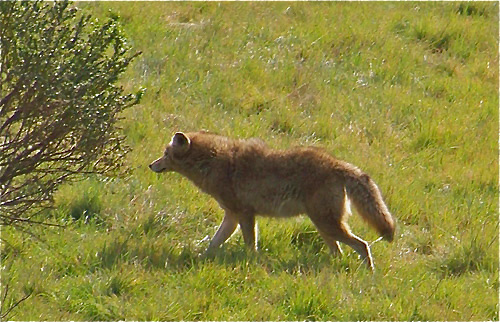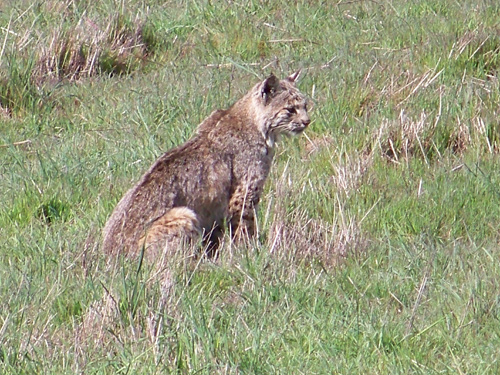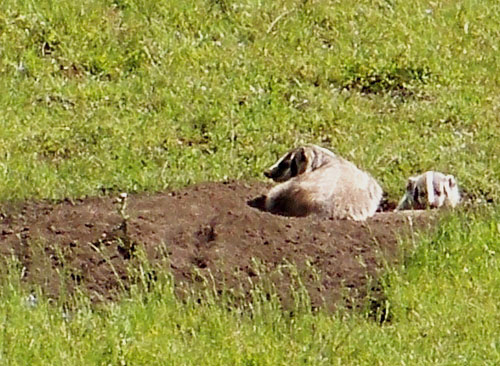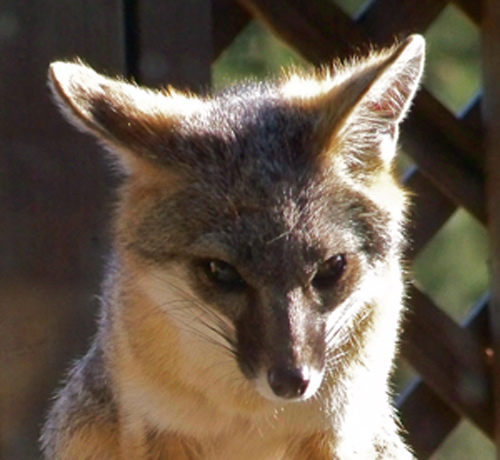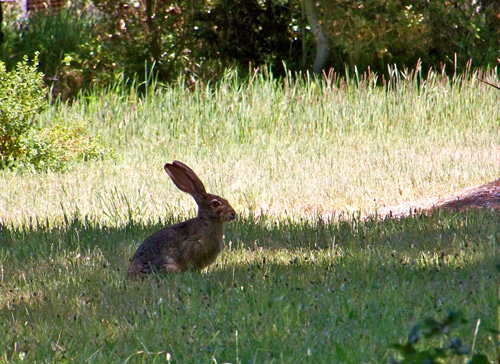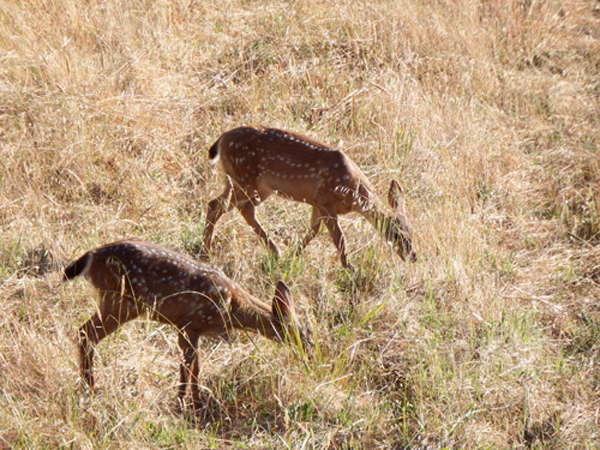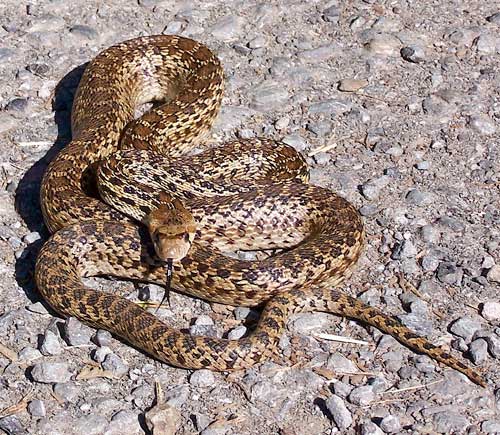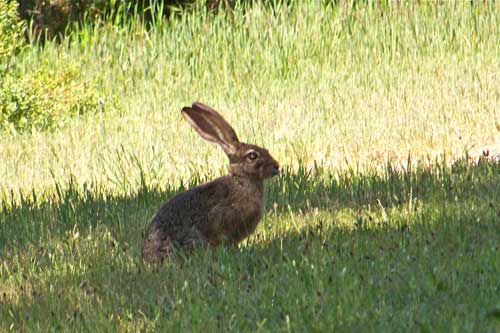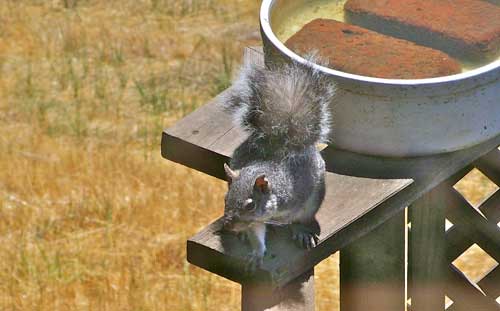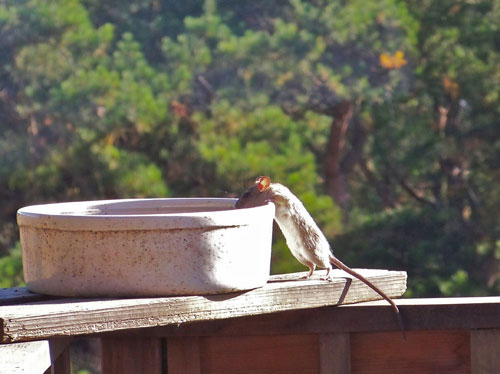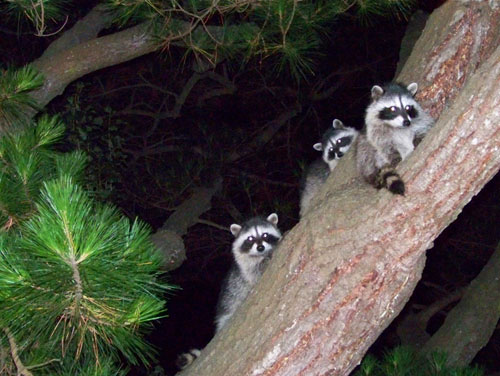Entries tagged with “possum”.
Did you find what you wanted?
Tue 23 Aug 2022
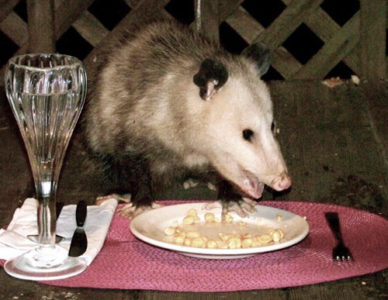 Once upon a time, I taught this possum proper table manners. 🙂
Once upon a time, I taught this possum proper table manners. 🙂
Getting him to eat with a knife and fork instead of his fingers was the biggest challenge.
More oddities. Last February, this blog reported: “The oddest West Marin news in the past fortnight came in the Feb. 3 Point Reyes Light. Here it is word for word. ‘Sheriff’s Call — Sunday, Jan.10: NICASIO: At 7:42 p.m. a woman who said she was moving to town from Southern California reported that someone who works at the post office was shooting metaphorical arrows, meaning witchcraft and sorcery, and that God had told her she needed to eradicate witchcraft and sorcery. She said the man was going to make her have demonic serpent offspring and she could not report him to his supervisor because the supervisor was likely in the same region of warlocks, and she wanted to assure deputies that she had not been struck by the arrows because she was protected by the blood of Jesus — she had an X-ray to prove it.'”
Postal sorcery seems to have now spread west. A sheriff’s call in the Aug. 11 Light reported: POINT REYES STATION: “A woman moving back to the area from Los Angeles said a former postal worker was tracking her with witchcraft and sending arrows to her head.” If it is the same woman, I hope the blood of Jesus is still protecting her.

Three roof rats scamper around our deck eating some of the seeds we’ve put out for wild birds. A professional gardener in town this week said the local roof-rat population “exploded” this year.

Roof rats take advantage of our bird ‘sanctuary’ in more than one way. Here a roof rat drinks from our birdbath. The roof rat’s pale underside helps distinguish it from brownish-gray Norway rats. Despite their name, Norway rats are believed to have originated in Asia and spread westward through Russia. Once in Europe, Norway rats in the 18th century were inadvertantly introduced worldwide when they hid on trading ships, often in the cargo.

Norway rats are sometimes referred to as sewer rats because they are often found in big city sewers. Here a sewer rat pokes its head out its front door. Norway rats can damage homes with their gnawing and can spread diseases. MPHonLine photo
Wed 15 Jun 2022
Posted by DavidMitchell under History, Photography, Point Reyes Station, West Marin nature, Wildlife
Comments Off on Natural coexistence
Caveat lectorem: When readers submit comments, they are asked if they want to receive an email alert with a link to new postings on this blog. A number of people have said they do. Thank you. The link is created the moment a posting goes online. Readers who find their way here through that link can see an updated version by simply clicking on the headline above the posting.

A family of raccoons enters the kitchen of Mitchell cabin in search of food. They were given some bread, but not in the kitchen.
Living in West Marin means living with nature. The surprise is how often nature manages to live with itself.

A blacktail buck and a bobcat foraging near each other on the hillside above Mitchell cabin. Each was aware of the other but didn’t seem to care.

A possum, fox, and raccoon eat kibble nose to nose just outside our kitchen door.
 Likewise dining side by side are this towhee and roof rat nibbling birdseed off our picnic table.
Likewise dining side by side are this towhee and roof rat nibbling birdseed off our picnic table.
 One surprising relationship went on for years around this part of town. This peacock was often seen in the company of a flock of wild turkeys. Unfortunately, I haven’t seen the peacock in recent months. I hope it’s okay. (Sad update: Obviously, not all species of wildlife are friendly toward each other, and the day after this posting went online, a neighbor told me a bobcat had killed the peacock.)
One surprising relationship went on for years around this part of town. This peacock was often seen in the company of a flock of wild turkeys. Unfortunately, I haven’t seen the peacock in recent months. I hope it’s okay. (Sad update: Obviously, not all species of wildlife are friendly toward each other, and the day after this posting went online, a neighbor told me a bobcat had killed the peacock.)
Just how close different species can live to each other was epitomized Tuesday evening. I had been lying on a couch in the living room listening to music when I got up and spotted a raccoon a few feet away eating kibble put out for our cat. The raccoon had managed to get inside because our kitchen door had been left open a few inches. It soon departed by the same route.
Fri 27 Aug 2021
Posted by DavidMitchell under Uncategorized
Comments Off on Where have all the badgers gone?
To get away from the present grim realities of human society, as were discussed here last week, this week we’ll take a few looks at the fascinating realities of the non-human society that’s seen around Mitchell cabin.

This past week, my wife Lynn spotted a bobcat in a persimmon tree next to our front steps. It’s not that we live in a literal zoo. Bobcats are fairly common here and elsewhere in Point Reyes Station.

Pouncing. A bobcat pounces on a gopher not far from our deck.
Coyotes. Predators even more noticeable are the coyotes. This one is looking at my parked car. Most nights the coyotes on this hill howl to establish territory. Contrary to widespread opinion, coyotes do not howl to announce a kill, for that would invite other coyotes to steal the prey.

Grey foxes are another set of predators we see fairly often. These are just outside the kitchen door scouring up the last of the kibble I had earlier given to some raccoons.

Badgers. Where did they go? When I first moved to this hill 45 years ago, there were a number of badger burrows. I spotted this pair one morning when I looked up from the breakfast table. They were easily visible on a nearby hillside. From their burrow’s entrance, the sow and cub were keeping an eye on the world. New badger holes used to be annual events here, but I haven’t seen a new one in five years or more.

Chipmunks are totally absent from our hill. This one apparently wandered over from Inverness Ridge a decade ago, but it didn’t stick around.

Gray squirrels can be a nuisance, and controlling them is an annual topic for discussion around here. The squirrels like to eat the cambium layer just under the bark on pines, often killing the ends of the limbs they munch on.
 The possums we see around here are Virginia Opossums, which are native to North America. Their lifespan is typically around four years. Possums are marsupials with counterparts found in Central and South America, New Zealand, and Australia.
The possums we see around here are Virginia Opossums, which are native to North America. Their lifespan is typically around four years. Possums are marsupials with counterparts found in Central and South America, New Zealand, and Australia.
To quote Wikipedia: “A marsupial is a mammal that raises its newborn offspring inside an external pouch at the front or underside of their bodies. In contrast, a placental is a mammal that completes embryo development inside the mother, nourished by an organ called the placenta.”

A jack rabbit in our backyard. As noted here before: “Jackrabbits were named for their ears, which initially caused some people to refer to them as ‘jackass rabbits.’ The writer Mark Twain brought this name to fame by using it in his book of western adventure, Roughing It. The name was later shortened to jackrabbit.”
Raccoons and skunks end up eating together so often they get along with each other fairly well.

A blacktail buck makes his daily appearance grazing beside Mitchell cabin. Of all the creatures I see, the bucks seem to have the most regal bearing.
Wed 16 Jun 2021
Posted by DavidMitchell under Uncategorized
Comments Off on Wild times continued during the lockdown
Caveat lectorem: When readers submit comments, they are asked if they want to receive an email alert with a link to new postings on this blog. A number of people have said they do. Thank you. The link is created the moment a posting goes online. Readers who find their way here through that link can see an updated version by simply clicking on the headline above the posting.
My wife Lynn dealt with the tedium of the shelter-in-place lockdown in part by watching British murder mysteries in the evening. I myself seldom watch TV and instead endured the lockdown by watching the wildlife around Mitchell cabin. Here’s what I’ve been seeing.

A raccoon and a gray fox got together for an ecumenical dinner outside our kitchen door Monday night. Raccoons can be aggressive when other raccoons try to horn in on their kibble snacks, but foxes and skunks get a free pass.

Wild turkeys are regular visitors to our fields, often accompanied by a lonely peacock whose screams sound like a woman crying out for help.

A stinky trio, three skunks march around the field above Mitchell cabin in tight formation.

Jackrabbits are showing up more as summer approaches.

A squirrel stops by our birdbath for a drink.

A roof rat and towhee have an ecumenical dinner of their own, quietly snacking on birdseed atop our picnic table.

The local bobcat walked downhill toward Lynn Monday while she was transplanting nasturtiums in our garden. When the bobcat saw her, it didn’t abruptly flee but merely trotted off into a neighboring field. My homeless friend, Billy Hobbs, tells of having an unconcerned bobcat walk quite close to him while he was sleeping along Papermill Creek near the Green Bridge. “I’ll bet it’s the same one,” he said Tuesday when I told him of Lynn’s encounter. (For the moment, Billy is being housed in Motel 6 at county expense.)

Other predators that keep us company are coyotes who howl for our entertainment more nights than not.
During the pandemic lockdown, enough people were staying at home that coyotes began more freely wandering about in nearby San Francisco, with experts estimating there are 40 to 70 of them.
Fri 19 Feb 2021
Posted by DavidMitchell under Uncategorized
Comments Off on Looking animals in the eye
This week we’ll look animals, both domestic and wild, in the eye to get a sense of what they see.

Newy, the stray cat we’ve taken in and who has been mentioned here before, can have an intense gaze when she’s looking off at something. It’s noticeable enough that it prompted me to look into, so to speak, the eyes of not only cats but other animals as well. A cat’s vision is not as all-powerful as it appears. A cat is most sensitive to blues and yellows and does not see colors like red, orange, or brown.

A blacktail doe looks up from grazing outside our bedroom window. The pupils in a deer’s eyes are horizontal, not round, and a flash camera makes them look blue.

A coyote displays his predatory nature as he stares into a field. As it happens, just now as I type this, coyotes are howling outside Mitchell cabin. (Photo by neighbor Dan Huntsman)

The no-nonsense look of a bobcat in the field below Mitchell cabin.

Foxes too are predatory, but their gaze makes them appear more curious than vicious.

Possums have good night vision but don’t distinguish between colors very well. Overall, their vision is so weak they must depend on smell and touch to find food.

Skunks, like possums, have very poor vision and navigate largely via their senses of smell and hearing.

Wild turkeys, on the other hand, see in color and “have an excellent daytime vision that is three times better than a human’s eyesight and covers 270 degrees,” according to ‘Facts about Wild Turkeys.’ “They have poor vision at night, however, and generally become warier as it grows darker.”

‘Livingbird Magazine’ reports that “Great Blue Herons can hunt day and night thanks to a high percentage of rod-type photoreceptors in their eyes that improve their night vision.” Near Mitchell cabin, a gopher with the baleful stare of death hangs from the heron’s beak.

Buzzards have such “keen eyesight,” Seaworld claims, that “it is believed they are able to spot a three-foot carcass from four miles away on the open plains.”

A stern stare. Coopers Hawks are skillful hunters and like other hawks have excellent vision.

The smirk of a Western Fence Lizard (also known as a Blue Belly for obvious reasons). It’s one of the most common lizards around Mitchell cabin. As for their vision, most lizards have excellent eyesight, and some can see into the UV spectrum.

Somehow my work glove hand ended up on the persimmon, and my bare hand on the barbed-wire fence. (Photo by Lynn Axelrod Mitchell)
This moment became a test of my vision and not in looking at the persimmons growing between the fields of Mitchell cabin and Arabian Horse Adventures. After some staring, I concluded that the Arabian waiting patiently for a persimmon is, in fact, a female mule. Nonetheless, I eventually gave her some fruit. Later I found out the mule had arrived in the pasture not long ago after its owner died. So far I’ve never seen any of the stable’s trail riders on it. Arabian Mule Adventures.
Tags: animal eyesight, blacktail deer, blue belly, buzzards, Cooper's hawk, foxes, Great blue heron, jackrabbit, mule, possum, skunks, Western fence lizard
Tue 9 Feb 2021
Posted by DavidMitchell under Uncategorized
Comments Off on Humor to make Valentine’s Day on Sunday even happier

Happy Valentine’s Day from the Canada Geese at Mitchell cabin.
____________

The behavior of a crazed loser did not originate with Donald Trump, as this 1982 New Yorker cartoons illustrates.
_________

Formal debate had already begun replacing aggressive prosecution in another 1982 New Yorker cartoon. I had considered the gladiators-versus-lions in the Roman Coliseum the ultimate high-stakes event. It never occurred to me a lion might have to to impeach a histrionic gladiator who had overindulged his sense of entitlement.
_________

As noted here before, my obligation to encourage wildlife a few years back led me to teach this possum dining etiquette. You could safely invite him in for your Valentine’s Day dinner. He’s certainly no Covid-19 carrier.
_________

Is this a Senate committee hearing or just another hungry-and-thirsty American in search of sustenance?
_________

___________

__________

From a 1958 New Yorker
__________

As part of my program to refine wildlife, I once mentored a bodhisattva possum on its path to enlightenment.
__________

What was Edouard Manet picturing in Le Déjeuner sur l’herb’? Lunch on the grass.
__________

__________

And a hearty Happy Valentine’s Day! from the raccoon I’ve trained to work as a flower vendor and who, I might add, would be only too happy to provide the bouquet for your celebration.
I hope all this provided a ray of sunshine in these semi-dark times.
Wed 19 Feb 2020
Posted by DavidMitchell under Photography, West Marin nature, Wildlife
Comments Off on Some of the critters that have been visiting here of late
Caveat lectorem: When readers submit comments, they are asked if they want to receive an email alert with a link to new postings on this blog. A number of people have said they do. Thank you. The link is created the moment a posting goes online. Readers who find their way here through that link can see an updated version by simply clicking on the headline above the posting.
Needing a break from the political scene, I spent much of the past week photographing the critters that show up at Mitchell cabin.

Eleven blacktail deer grazing near Mitchell cabin last Saturday.

Following the deer up the hill were 21 wild turkeys.

Which led to an unusual stare-down.

For almost three years there’d been a dearth of possums around Mitchell cabin, but this past week two showed up on our deck after dark to nibble kibble.

Here a possum and raccoon dined together with no confrontations Sunday evening.

Raccoons, of course, are fairly comfortable around a number of other animals. Here four of them ate kibble alongside a skunk last fall.

And here a possum dined contentedly between two gray foxes just outside our kitchen door awhile back.

But the most integrated dining I have seen were this possum, fox, and raccoon, which I photographed together next to the kitchen door in 2011.

Monday morning Lynn woke me up so I could see this sharp-shinned hawk on the railing of our lower deck. The young hawk’s expression is mighty stern, and I fear it may be hunting the birds that show up on our upper deck to eat birdseed. (Photo by Lynn Axelrod Mitchell)
In short, not all wildlife live in harmony around here.
Tue 8 Oct 2019
Posted by DavidMitchell under West Marin nature, Wildlife
Comments Off on The charm of inter-species neighborliness
Caveat lectorem: When readers submit comments, they are asked if they want to receive an email alert with a link to new postings on this blog. A number of people have said they do. Thank you. The link is created the moment a posting goes online. Readers who find their way here through that link can see an updated version by simply clicking on the headline above the posting.
Some critters get along with their animal neighbors better than we might expect. Here’s a look at some inter-species neighborliness that’s caught my eye around Mitchell cabin.

A curious black-tailed doe watches a housecat clean itself.

A great blue heron goes gopher hunting near Mitchell cabin beside a grazing deer.

Seven wild turkeys hunt and peck alongside four black-tailed deer.

Wild turkeys, in fact, can often be found roaming around with other creatures, such as this lone peacock.

A scrub jay and a roof rat comfortably eat birdseed side by side on our picnic table.

Towhees are nowhere near as brazen as jays, but this one seems unconcerned about eating next to a roof rat.

Raccoons and skunks manage to dine together on our deck almost every night. As previously noted, raccoons, like dogs, identify each other by sniffing rear ends, including the backsides of skunks. The skunks often shoulder aside raccoons while competing for food but for some reason never spray them.

Another milepost in inter-species mingling: a possum, fox, and raccoon eat nose to nose to nose outside our kitchen door.
Sun 21 Jun 2015
A year ago I was hit with a medical problem called temporal arteritis, which sent me to the emergency room at Kaiser Hospital in Terra Linda. As I wrote here at that time, it was a big headache, but left untreated it could have led to blindness.
Temporal arteritis amounts to inflammation of an artery that goes through the temples (hence the name ‘temporal’) and feeds blood to the eyes. The problem is common enough that rheumatologists have developed a standard treatment using the steroid Prednisone. The cause of temporal arteritis is unknown, but it mostly hits us older folks.
Well, the Prednisone worked in that it took away the headache, but I had to consume it every day, and that itself produced temporary problems ranging from less-focused thinking to a loss of balance. I began taking increasingly serious falls. The worst was on Memorial Day when I fell to the ground from a standing position. I landed on stainless-steel metal and badly bruised the right side of my ribcage.
I had just about recovered from that fall when today I stumbled on my deck and landed on the left side of my rib cage. What a pain! As a result, I’m taking it easy on myself, which is why my posting this week consists of photos from my collection, not ruminations. Most of them have appeared here previously.

Gray squirrel at my birdbath.

The raccoons around Mitchell cabin are amazingly adventurous. These walked right in when I left the kitchen door open.

Three animals who seldom hang out together in nature, a possum, fox, and raccoon, were convinced to eat peaceably together when I scattered honey-roasted peanuts on my deck. Animal populations, however, go up and down, and I haven’t seen many foxes or possums around Mitchell cabin recently.

A blacktail doe takes a rest behind my woodshed.

Two does and a flock of wild turkeys forage side by side uphill from Mitchell cabin, both species seeming oblivious of the other.

Two years ago, a lone peacock began keeping company with the turkeys. It’s pretty but its calls sound like a woman in distress.

Coyotes can often be heard at night howling around Mitchell cabin. Getting a chance to see one is far less common.

It’s far more common to see bobcats. Here one takes a rest while hunting downhill from the cabin.

A mother badger with her kit. The most ferocious predators near the cabin are badgers. Even a bear would be no match. Badgers live in burrows up to 30 feet long and 10 feet deep, for they are remarkably efficient diggers thanks to long claws and short, strong legs. Although they can run up to 17 or 18 mph for short distances, they generally hunt by digging fast enough to pursue rodents into their burrows.

Lost in thought, a gray fix sits on my picnic table.

Jackrabbits, of course, are always around. Jackrabbits, which are also known as black-tailed hares, avoid predators by using “an element of surprise and escape that works well,” Point Reyes Station naturalist Jules Evens notes in his Natural History of the Point Reyes Peninsula.
“When a potential predator is detected, the hare will usually take shelter in the shade of a convenient clump of vegetation or behind a rock and freeze motionless. If the predator approaches very closely, the hare leaps into stride, zigzagging across open country until it finds shelter.”

Two young does graze beside Mitchell cabin. To me all this is my home on a hill, but it could just as easily be a zoological garden.
Tags: badgers, blacktail deer, bobat, coyote, fox, gray squirre, jackrabbit, peacock, possum, raccoons, wild turkeys
Mon 5 Jan 2015
Posted by DavidMitchell under West Marin nature, Wildlife
Comments Off on A gallery of the critters around Mitchell cabin
 Around the first of the year I sometimes post a roundup of the creatures that have shown up around Mitchell cabin.
Around the first of the year I sometimes post a roundup of the creatures that have shown up around Mitchell cabin.
This year I’m doing it again, starting with a butterfly and dragonfly followed by a variety of larger critters.
This exhibit ends with a coyote, a bobcat, two badgers, and two deer rubbing noses.
Regular readers of this blog will recognize some of these photos from past postings.
Here a buckeye butterfly rests on a chrysanthemum that’s growing in a flowerpot on the deck. ___________________________________________________________________

A dragonfly pauses on the twig of a tree that’s next to the deck. Dragonflies can easily be distinguished from damselflies because when they are at rest they leave their wings extended while damselflies close their wings over their bodies when at rest. __________________________________________________________________
 A Pacific tree frog on a bamboo shoot near our hot tub.
A Pacific tree frog on a bamboo shoot near our hot tub.
Some people call them Pacific chorus frogs. During the winter, their main mating season, males make their way to water and then charm females to the water with a chorus of chirping.
________________________________________________________________

Gopher snakes are not poisonous, but they mimic rattlesnakes, coiling up and wagging their tongues when threatened. This one was near the foot of our driveway.

A jackrabbit in the field outside our kitchen window pauses to look around .

This is the only chipmunk I’ve ever seen around Mitchell cabin. I’m just glad I had my camera nearby when it showed up.

A Western gray squirrel basks in the sun after taking a drink from our birdbath.

A roof rat takes a drink from the birdbath. These rats originated in southern Asia, and you’ll recall it was their fleas that spread the Black Death throughout Europe in the 14th Century, killing roughly half the people.

This cute possum used to be a regular nighttime visitor, but so many raccoons have been hanging around the cabin in the evening that we seldom see any possums these days.

Three raccoons in a tree beside Mitchell cabin. ______________________________________________________________
 A gray fox enjoys the sun on our deck.
A gray fox enjoys the sun on our deck.
_________________________________________________________________

A coyote watches me park my car as I arrive back home.

A bobcat hunts outside our kitchen window.

A mother badger and her kit eye the world from their sett, as badger dens are called.

Two deer touch noses as a herd of six blacktails graze downhill from Mitchell cabin.
For reasons of space, no birds are included in this posting. Look for a gallery of our fine feathered friends in a week or two.
Tags: badgers, blacktail deer, bobcat, Buckeye butterfly, chipmunk, coyote, damselfly, dragonfly, gopher snake, gray fox, jackrabbit, Pacific tree frog, possum, raccoons, racoons, roof rat, Western gray squirrel
 Once upon a time, I taught this possum proper table manners. 🙂
Once upon a time, I taught this possum proper table manners. 🙂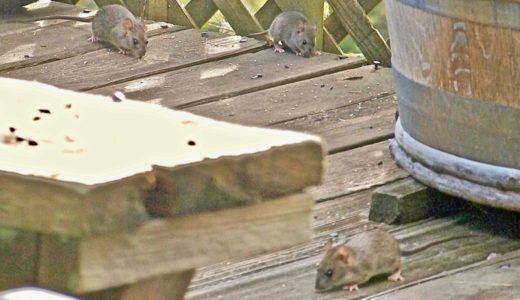
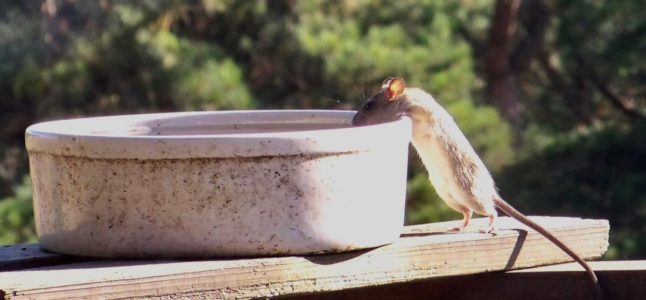
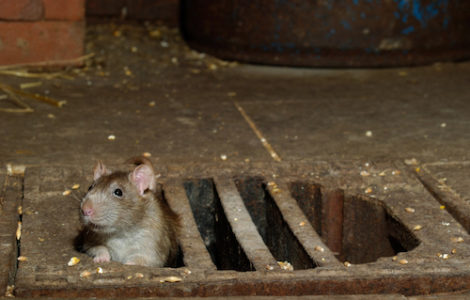

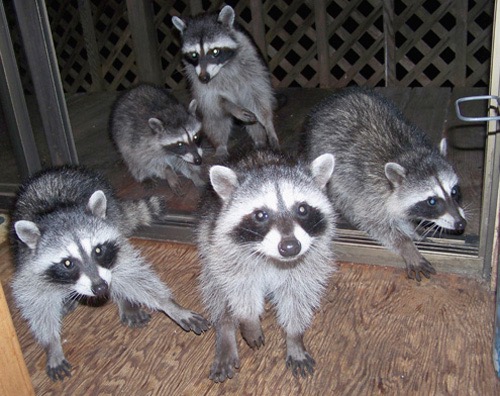
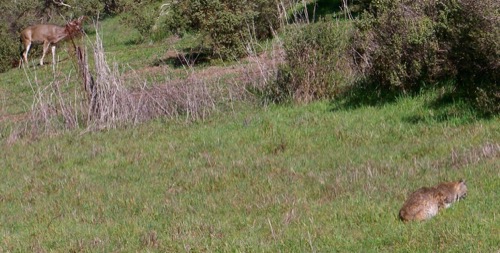
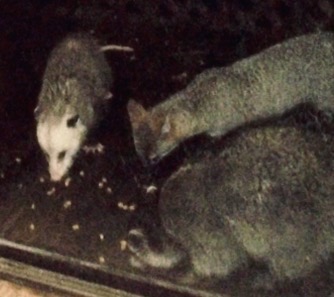
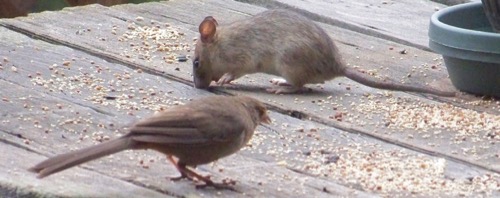 Likewise dining side by side are this towhee and roof rat nibbling birdseed off our picnic table.
Likewise dining side by side are this towhee and roof rat nibbling birdseed off our picnic table.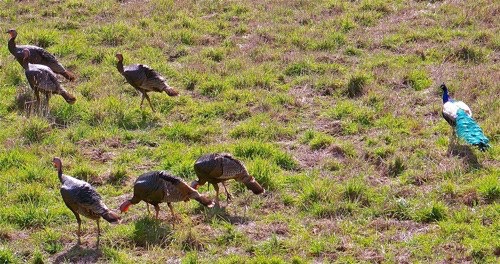 One surprising relationship went on for years around this part of town. This peacock was often seen in the company of a flock of wild turkeys. Unfortunately, I haven’t seen the peacock in recent months. I hope it’s okay. (Sad update: Obviously, not all species of wildlife are friendly toward each other, and the day after this posting went online, a neighbor told me a bobcat had killed the peacock.)
One surprising relationship went on for years around this part of town. This peacock was often seen in the company of a flock of wild turkeys. Unfortunately, I haven’t seen the peacock in recent months. I hope it’s okay. (Sad update: Obviously, not all species of wildlife are friendly toward each other, and the day after this posting went online, a neighbor told me a bobcat had killed the peacock.)
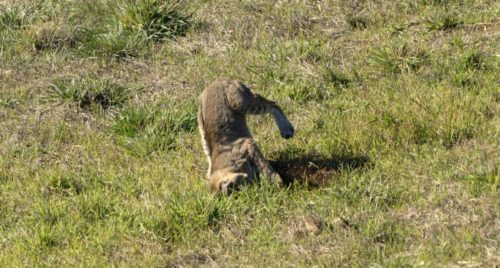
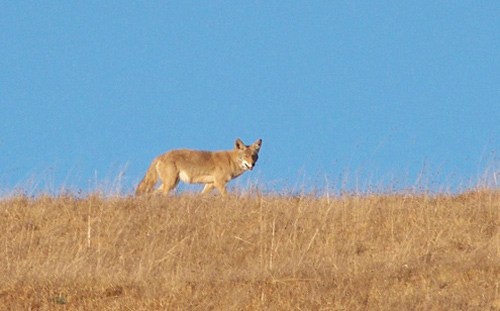

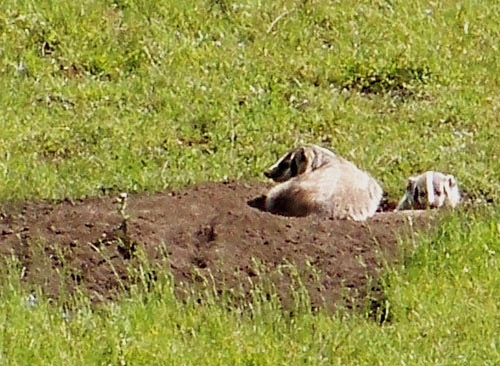

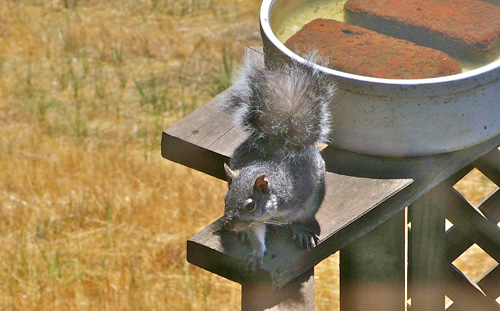
 The possums we see around here are Virginia Opossums, which are native to North America. Their lifespan is typically around four years. Possums are marsupials with counterparts found in Central and South America, New Zealand, and Australia.
The possums we see around here are Virginia Opossums, which are native to North America. Their lifespan is typically around four years. Possums are marsupials with counterparts found in Central and South America, New Zealand, and Australia.

